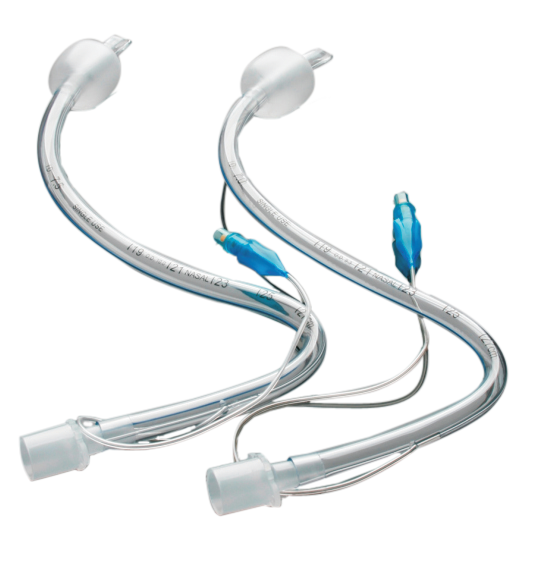
Nasal Preformed Tracheal Tube, Cuffed High volume low pressure cuff
The nasal preformed tracheal tube, cuffed, is a medical device that is inserted into the nose and used to provide a airway during medical procedures. It is made of soft, pliable material and has a inflated cuff that helps to keep it in place. The tube is connected to a breathing machine that provides oxygen and other gases.
| Ref. No.: | Size: | Qty. Cs: |
|---|---|---|
| NMR100330 | 3.0 | 100 |
| NMR100335 | 3.5 | 100 |
| NMR100340 | 4.0 | 100 |
| NMR100345 | 4.5 | 100 |
| NMR100350 | 5.0 | 100 |
| NMR100355 | 5.5 | 100 |
| NMR100360 | 6.0 | 100 |
| NMR100365 | 6.5 | 100 |
| NMR100370 | 7.0 | 100 |
| NMR100375 | 7.5 | 100 |
| NMR100380 | 8.0 | 100 |
| NMR100385 | 8.5 | 100 |
| NMR100390 | 9.0 | 100 |
| NMR100395 | 9.5 | 100 |
| NMR100310 | 10.0 | 100 |
The nasal preformed tracheal tube, cuffed, is a medical device that is inserted into the nose and used to provide a airway during medical procedures. It is made of soft, pliable material and has a inflated cuff that helps to keep it in place. The tube is connected to a breathing machine that provides oxygen and other gases.
A nasal preformed tracheal tube is a type of airway device that is inserted through the nose and into the trachea (windpipe). The device has a cuff that inflated to seal the trachea and prevent air leakage. The tube also has a port that allows for suctioning or ventilation.
Nasal preformed tracheal tubes, or cuffed tracheal tubes, are slightly different from other types of tracheal tubes in that they have a cuff that is inflated during surgery. This cuff helps to keep the tube in place and also prevents air from leaking around the tube.
One of the most common questions we get asked is what are the advantages and disadvantages of using a Nasal Preformed Tracheal Tube (NPFTT). While there are many factors that go into making this decision, here are some key points to consider.
Advantages:
1. Reduced risk of aspiration: NPFTTs are less likely to cause aspiration than other types of tracheal tubes because they have a smaller diameter and are placed higher in the airway.
2. Reduced risk of traumatic intubation: NPFTTs are designed to minimize the risk of trauma to the airway during intubation.
3. Easy to use: NPFTTs are easy to insert and remove, which can save time in the operating room.
Disadvantages:
1. Limited availability: NPFTTs are not widely available, so you may not be able to find one when you need it.
2. Higher cost: NPFTTs are more expensive than other types of tracheal tubes.
3. Increased risk of complications: Although rare, there is an increased risk of complications with NPFTTs, such as bleeding or obstruction.
A nasal preformed tracheal tube, also known as an NPETT, is a type of breathing tube that is inserted through the nose and into the trachea (windpipe). It is most commonly used during general anesthesia, but can also be used in other situations where a patient needs assistance with breathing. The NPETT has a number of advantages over other types of breathing tubes, including its small size and the fact that it does not need to be inserted through the mouth.
Inserting a Nasal Preformed Tracheal Tube (NPFTT) is a skill that every medical professional should know. Though it may seem daunting at first, with a little practice it can be easily mastered. Here are some tips on how to insert an NPFTT:
1. Before beginning the procedure, be sure to have all the necessary supplies on hand. This includes the NPFTT itself, lubricant, gloves, and a syringe.
2. Start by lubricating the NPFTT. This will help it to slide in more easily.
3. Next, gently insert the NPFTT into the patient's nose. Aim for the area just behind the nasal bones.
4. Once the NPFTT is in place, inflate the cuff with the syringe. This will help to hold the tube in place and prevent it from falling out.
5. Finally, connect the NPFTT to any necessary breathing apparatus. This could include a ventilator or oxygen tank.
There are a few potential complications that can occur when using a nasal preformed tracheal tube. These include: displacement of the tube, kinking of the tube, and obstruction of the tube. Displacement occurs when the tube moves out of place, and can be a problem if not caught quickly. Kinking can occur if the tube is not positioned correctly, and can cause problems with breathing. Obstruction can occur if the tube becomes blocked, and can be dangerous if not addressed immediately.
The nasal preformed tracheal tube, cuffed, is a great option for those who need a little extra support when it comes to breathing. This type of tube is designed to fit snugly in the nose and provide a comfortable seal that helps to prevent air leakage. Additionally, the cuff helps to keep the tube in place and provides an additional level of protection against air leaks. If you are looking for a reliable tracheal tube that can help you breathe easier, then consider investing in a nasal preformed tracheal tube, cuffed.